PSAs for Automotive Bonding and Noise Reduction
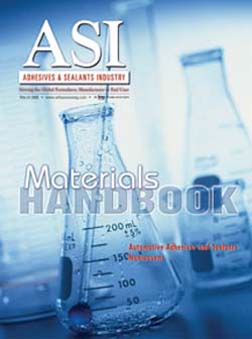
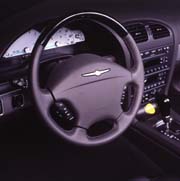
Automotive engineers now consider pressure-sensitive adhesives (PSAs) to be cost-effective assembly solutions that improve process speeds while significantly reducing NVH (noise, vibration, harshness) problems. Ideal for high-performance applications, PSAs are easy to apply, lighter than most mechanical fasteners and offer better stress distribution over a wider surface area. They are able to adhere strongly to difficult-to-bond substrates, offer both high- and low-temperature resistance, and are available in both permanent and repositionable form. PSAs can also be specially formulated to exhibit sound damping properties. Their ability to help suppress sound make these PSAs ideal choices for use in conjunction with a variety of substrates for NVH and anti-squeak and rattle applications.
PSAs are used in almost every step of vehicle manufacture. In some cases, fabricated components arrive from the supplier with the PSA already cut to shape and applied to the part. OEMs merely remove the liner and apply the part, thereby minimizing waste, eliminating mess, and reducing costs. Key PSA applications include mirror bonding, weather stripping, trim and emblem attachment, surface protection, NVH/anti-squeak and rattle applications, instrument panel and air bag assembly, occupant restraint systems, flooring and headliner attachment, and wire harness wrapping (see sidebar).
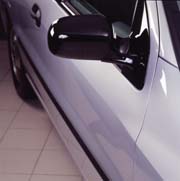
End-use conditions help determine which type of adhesive - rubber, acrylic or silicone - should be used for a given application. Typically, PSAs that contain rubber or modified rubber adhesives are best suited for applications in the 185-221°F temperature range, while acrylics perform best between 222°F and 257°F. Silicone adhesives are ideal for temperatures of 258°F and higher.
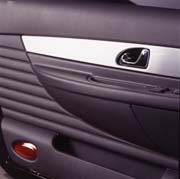
PSA Materials
Cloth tapes provide the most economical anti-squeak and -rattle protection, and are used for clip retention and harness wraps inside doors, instrument panels, and overheads. Single-coated PSAs made of woven and non-woven materials are often used as noise barriers under the hood, in the floorboards, under headliners and roof areas, in speaker covers, in glove boxes, and in the trunk. Base materials range from low-cost felts to high-cost composite wovens and flocks, and also include heat-reflective wovens as well as cotton or rayon materials for wire harness applications.Coated and uncoated cloth wire harness tapes offer superior sound deadening properties over PVC tapes. As they are halogen-free, cloth tapes are also more environmentally friendly than PVC materials. Double-coated foam tapes are used to control NVH in several areas of the vehicle. Flexible, low-cost PVC, crosslinked polyethylene, ether, and ester foams may be easily die-cut into the various shapes often required in NVH applications, such as gasketing, gap filling, cushioning, and sealing.
Other applications include vibration damping under the hood, suppression of squeaks and rattles inside doors and in HVAC systems, and road noise reduction in A, B, and C pillars. Foam PSAs also serve as quick fixes to stop rattles and squeaks discovered as the vehicle progresses along the assembly platform.
Adhesive coated low-density polyethylene (LDPE) films cover through-holes in the floorboard, doors and dashboard that may occur during model changeovers and redesigns. By covering these holes, OEMs reduce wind noise and the hissing of air squeezing through open spaces. Ultra high molecular weight (UHMW) polyethylene films reduce squeaking and prevent wear of metal surfaces that contact each other in applications such as seating tracks and door closures. The self-lubricating properties of UHMW polyethylene make it an ideal choice for wear/abrasion protection and impact resistance applications.
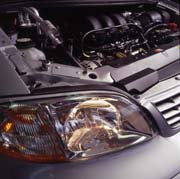
SIDEBAR: Case Study: Foam Tapes for Bonding and Gap Filling
Double-coated foam tapes have become an important solution to eliminate moisture and minimize NVH in automobile assembly. Tier 1 supplier McKechnie Vehicle Components, a specialist in engineered trim and wheel cladding, was using a strip butyl to provide a protective seal around the pre-cut light apertures on the tailgate assembly of the Ford Focus, one of the most popular vehicles on the road today and previous European 'Car of the Year' winner.Water was seeping through the butyl seal and affecting the lights' functionality. The butyl was applied manually - a slow and complicated process that hurt overall productivity. In addition, the tough and elastic nature of butyls made cutting difficult and caused unnecessary waste and mess during application.
Experts at McKechnie considered a number of possible explanations for the butyl's failure to protect against moisture. Was the substrate itself (e.g., the gasket or the tailgate) unsuitable for sticking to a butyl? Had the wrong type of butyl been selected? Was it being applied incorrectly? To resolve the problem as quickly as possible, McKechnie decided to outsource its bonding and sealing dilemma to a specialist. Scapa Automotive was called in to help identify the source of the problem and recommend an effective solution.
A project team headed by a Scapa Automotive application engineer began by auditing McKechnie's entire assembly process. Different combinations of adhesive, carrier and liner were tested on each substrate to find a solution capable of bonding the painted body containing the pre-cut light apertures to the chromed ABS plastic tailgate. Application of the adhesive itself was also a key part of the analysis.
From the potential products tested, a unique double-coated PVC foam tape (Scapa 5169) emerged as the clear solution. Its structure and composition brought a number of advantages compared with other bonding materials and provided solutions to all of McKechnie's application challenges.
The double-coated foam tape was able to bond and seal the assembly, providing an effective water barrier when compressed. It also acted as an anti-vibration pad, minimizing irritating rattles in the tailgate. In the previous process, the strip butyl material was only applied to certain sections of the gasket and tailgate, which was time consuming and resulted in gaps that allowed water ingress. Scapa created a ready-made die-cut gasket with holes the exact shape and size of the openings for the lights. The acrylic adhesive on both sides of the foam enabled firm bonding to both substrates, while its high conformability compensated for irregularities in both surfaces.
Using a ready-made die-cut gasket accelerated the production process, as Scapa 5169 adhered quickly with clean edges. The tape was incorporated into production of the vehicle by McKechnie and has since been successfully used in both the three- and five-door Ford Focus models.
While NVH improvement was a secondary benefit in the Ford focus application, PSAs are frequently used primarily for NVH in automotive designs. Lightweight body construction and the growing complexity of vehicle design make the task of minimizing NVH in vehicles increasingly difficult. Yet NVH-related issues are estimated to account for 30-40% of total customer complaints.
In a similar example, a leading automotive OEM was using a tape around the intricate corner edges of the rear quarter lights of a vehicle to absorb hollow sounds. However, the tape was difficult to apply and a second liquid adhesive had to be used to eliminate lifting at the edges - a step that further slowed the assembly process.
To solve the OEMs problem, Scapa developed a die-cut version of Scapa 3829, a single-sided foam tape. The die-cut piece could be easily applied around the complex corners, speeding and simplifying the assembly process and resulting in obvious cost efficiencies. The tape itself was selected to add mass and density around the window trim area and create a solid sound when tapped. This provided an effective cushion between the two substrates and improved quality. The die-cut shape and size of 3829 was specifically tailored to the application and eliminated the need for a wet adhesive.
For more information on PSAs, visit Scapa North America at http://www.scapana.com.
Looking for a reprint of this article?
From high-res PDFs to custom plaques, order your copy today!







